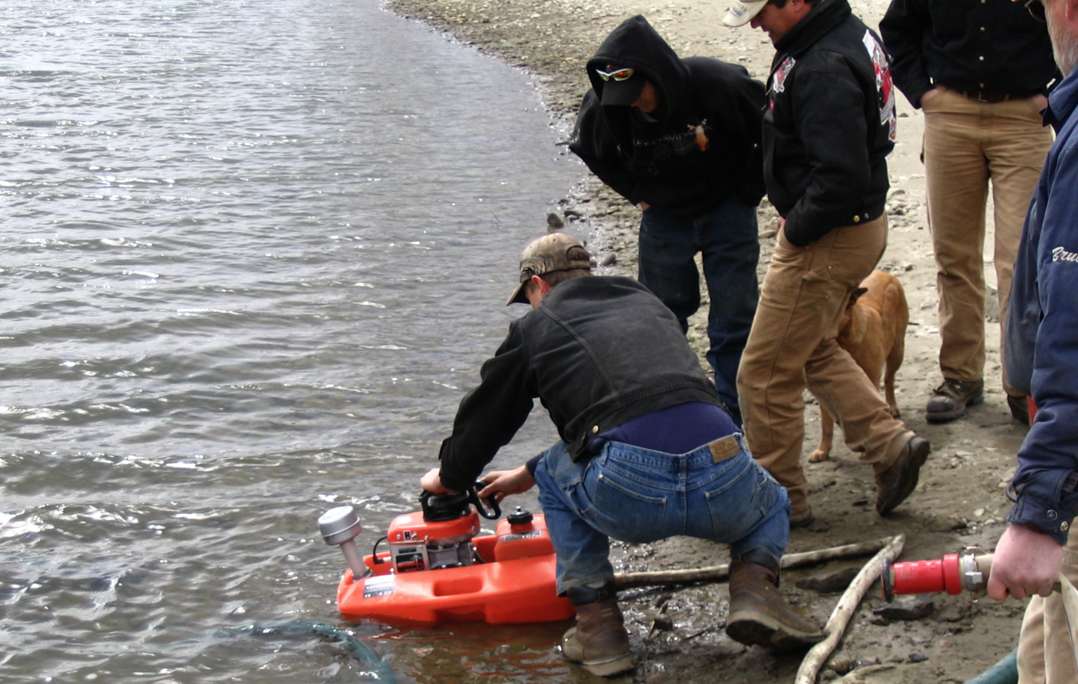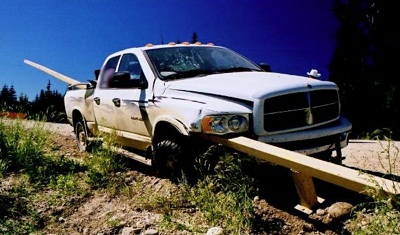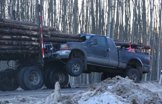DO NOT COPY - ALL contents - Copyright Protected
DRAM Ventures Inc. / www.firesafetraining.com
S-100A Part 4
Sections 16 - 20
DO NOT COPY - ALL contents - Copyright Protected
DRAM Ventures Inc. / www.firesafetraining.com
Contents
- Section 16 - 20
- 16 - Pumps & Water Delivery Systems
- 17 - Fuel Handling
- 18 - Emergency Radio Procedures
- 19 - L A A C E S
- 20 - Miscellaneous Safety Concerns
- W.H.M.I.S. (Workplace Hazardous Material Information System)
- Heat Stress
- Vehicles & Vehicle Fires (Watch the video)
- Animals
Complete Course Table of Contents

Waterous Floto Fire Pump demonstration for S100A Annual Safety Refresher Course for Wildland Fire Fighters (Photo - Doug Richardson)
Section 16 - Pumps & Water Delivery Systems
There are some extra safety precautions when working around pumps.
- Use hearing protection
- Ensure the pump site is not near danger trees or snags
- Ensure pump site is safe from falling rocks
- If the pump or the hose lay are on a road, flag the road to warn traffic
- Be cautious of a pump site beside a swift flowing river or deep lake or river bank shores (tie pump to tree)
- Be cautious of undercut river banks
- Set your pump on a flat, fuel free area (no dry grasses, etc.)
- Ensure there are escape routes away from the pump location
- Do not pick up a pump that has recently been running (hot muffler)
- Wear goggles as the hose lines and fittings can burst
Foam & other Retardants
If foam (or other retardants) are being used in the water delivery system - you must;
- Ensure there is no spillage into any water source
- Report any spills to your supervisor immediately
- If you get foam in your eyes or on your skin, wash immediately with large amounts of clean water.
- Report such incidents to your supervisor and first aid attendant
Section 17 - Fuel Handling
- When working with any fuel or other dangerous type of flammable material, exercise caution at all times.
- Never smoke near or have open flames near a fuel container.
- Do not spill fuel on your clothing.
- If you splash fuel into your eyes or on your skin, follow the same procedures as with Foam treatment above.
- If you spill fuel into a water system, follow similar procedures as with a Foam spillage.
- Always be specific when labeling containers (drums) of "waste" fuel. NEVER mix different types of fuel in "waste" drums.
Section 18 - Emergency Radio Procedures
- If you have an extreme emergency where your or someone else’s life is in danger, AND you must use a 2 - way radio, you MUST:
- Turn on the radio and turn up the volume
- Do not change the channel
- Hold radio upright, push the transmit button, and speak slowly and clearly, “Mayday, Mayday, Mayday”
- State your name
- State your location
- State nature of emergency
If you do not receive a reply, move a few meters to a new location and try again. Even if you do not receive a reply, transmit your complete message as sometimes you are being heard but cannot hear back. Someone, even a passenger airliner far overhead may have heard your Mayday call and passed on your message to the proper authorities. As a final resort, note the original channel you are using and then carefully try different channels.
When a Mayday call for help is received, ALL radio traffic except that of the assisting parties, must cease. You will only resume normal radio traffic when the Mayday is given the all clear.
If your emergency is NOT life threatening, you may say “Pan, Pan, Pan” or more commonly, “I have an emergency and require assistance”. Follow the above mentioned procedures.
Section 19 - L A A C E S
Remember the safe work procedures of L. A. A. C. E. S.
L - Lookouts. Post a lookout (experienced) to observe the fire conditions. (not always necessary, never use designated First Aid person) (report at least hourly)
- A - Anchor point. Start the fire guard (part of control line) at a safe location.
- A - Awareness (Situational) If you are clear on your "situational awareness and follow all safety procedures - you should be able to sleep in your bed at the end of your work shift.
- C - Communications. Maintain good communications at all times.
- E - Escape routes. Know where at least two escape routes are.
- S - Safe areas (zones.) Know where your safe zones are.
Section 20 - Miscellaneous Safety Concerns
W.H.M.I.S. Workplace Hazardous Material Information System
- This is regulated by W.C.B. (WorkSafe B.C.) and it is mandatory that every worker must be trained in this system. It provides the worker with important information about hazardous material they may be working with at the work site. W.H.M.I.S. describes the hazards of materials used and tells the worker what safety precautions to take when using them. If a container has a
Below is the original. 1988 WHMIS Label. The new, 2015 WHMIS/GHS has a solid border.
- (gasoline and diesel should have such a "hatched" border label) you must read the label and follow instructions. The label will refer you to a M.S.D.S. (Material Safety Data Sheet) The new, 2015 WHMIS/GHS information sheet is called an S.D.S. (Safety Data Sheet.) Your employer must have these sheets available for your access. Ask where they are located.
This is not a W.H.M.I.S. course. (See our Online NEW WHMIS Course Information). - HOME PAGE.
Only your employer can give you current information regarding the dangerous material you may be using or are exposed to.
You have a responsibility to ask questions regarding safety issues.
- Poor physical fitness
- Lack of acclimatizing to the local conditions
- Overweight
- Increased age (40 and up do not cope so well)
- Pre-existing medical conditions and treatments
- Short-term medical issues (i.e. cold, flu, diarrhoea)
- Chronic skin disorders
- Some medications (do not take aspirin or non-steroidal anti-inflammatory drugs as a cure)
- Alcohol or recreational drugs
- Previous heat stroke
- Heat Cramps
- Heat Exhaustion
- Heat Stroke
Heat Stress
Heat Stress is a serious situation and must be treated accordingly. Fire fighters are in a work environment that can increase this risk. Heat stress can quickly progress to a life-threatening situation.
Some Personal pre-existing factors which may lead up to Heat Stress:
There are three levels of Heat Stress
1. Heat Cramps
- Excessive sweating
- Muscle cramping / pain
2. Heat Exhaustion
- Sweating
- Muscle cramps
- Feel tired, week, poor muscle control
- May slur speech
- May stumble frequently
- Cool, clammy skin, pale complextion
- Faster, shallow breathing usually with a rapid pulse
- Dizziness / Fainting
- Headache / feeling sick (nausea)
3. Heat Stroke
- Usually no sweating
- Hot, dry and flushed skin
- Worker may be confused / agitated (also in denial of any major problem)
- Probable stumbling
- Probable slurred speech
- Headache, nausea and possible vomiting
- Rapid and shallow breathing
- Probable irregular pulse
- Probable seizures and fainting
- Probable shock and cardiac arrest
- Probable death if left untreated
Basic Treatment: The worker must be cooled immediately. Remove clothing, cool with sponge or sprayed water. Get medical assistance. If worker is alert, give worker water to drink. Worker may drink salty water but do not take salt tablets.
THIS IS A SERIOUS AND POTENTIALLY FATAL SITUATION. ACT ACCORDINGLY.
- Special thanks to Bill Laflin, (RPF / Level 3 EMP) and to W.C.B. for their valuable input on Heat Stress
- Vehicles
- for broken lights, mirrors, etc.
- dents
- telltale oil, grease around wheel lugs, bearings, and fluids under the vehicle
- look at tire condition - don’t forget the spare!
- look under the hood for loose belts, check the fluid levels, and worn hoses, etc.
- when inside, check all gauges, seat belts and door handles are all working properly
- first aid kit and fire extinguisher
- general cleanliness
- know where you are going
- do not “cut” corners
- do not drive close to the shoulders - especially after a rain or in the spring time
- straddle deep ruts
- do not “play Rambo” with your vehicle - keep it on the roads
- know that your brakes may not work well immediately after driving through water
- gear down
- drive slowly over washboard to avoid “a side bounce”
- approach all bridges and cattle-guards with caution
- ensure all passengers are wearing seat belts
- Slow Down! The Ministry of Forests and the B.C. Forest Safety Council are now monitoring some logging roads with radar
The Driver:
- is responsible for the safe operating condition and operation of the vehicle. Drivers must do a pre-inspection which would include such items as a circle check.
Driver is checking:
Driving:
It should be clearly understood that most motor vehicle accidents on back country or forest industry type roads are primarily caused by inexperienced drivers with poor driving skills, often combined with excessive speed.
 The above situation appears to be on a straight portion of road. - was this,
|
 |
Vehicle Fires
- Never approach from the front or rear.
- Tires can also explode and cause serious harm.
- Vehicles fires are extremely dangerous! (Even if a fully trained structural fire crew attends a vehicle fire, most often the vehicle is a total "write-off" anyhow.)
Why Wildland Fire Fighters DO NOT FIGHT VEHICLE FIRES
The following video is a clear demonstration of what can happen with some bumpers (nitrogen filled absorbers) during a fire.
Summary - Wildland Fire Fighters do NOT attempt to fight vehicle fires!
When water "hits" magnesium!
"gas" filled bumper shock absorbers, exploding
Motorhome fire - part way into video you will hear and see the propane tank, venting, as they are designed to do. Note how close the people taking the video are to the motorhome. ... and then watch the video below.
Propane BLEVE! (Boiling Liquid Expanded Vapour Explosion)
WILDLAND FIREFIGHTERS (YOU) ARE NOT TRAINED OR EQUIPPED TO FIGHT VEHICLE OR HOUSE FIRES!
BEST ACTION FOR A PROPANE OR POTENTIAL PROPANE FIRE - SET UP A BLOCKADE AND KEEP "CIVILIANS" A MINIMUM OF 1 / 2 MILE FROM INCIDENT!
- Animals / Bears
Like all animals, they are opportunists. Their “grocery store” is in the bush and if we are working a fire, (or conducting any other forestry activity) we are in or near their “turf” and we must not add our food to their “grocery store”.
Pick up all garbage and maintain a clean, food free, fire line and work camp. A bear passing through, that does not find extra “goodies” will generally not return after about three days and may not become a problem bear. There is usually no need to shoot a bear the first time he/she comes near the work site or camp.
If they do continue to be a problem they must be dealt with by the proper authorities.
Rattlesnakes
These animals are protected and must not be killed “just because we can”. A rattlesnake will not stalk you. If given the chance it will move away. Give it that chance. If you are working in rattlesnake country do NOT put your hands in holes while cold-trailing! Wear your pants loose over the top of your boots. If you are bitten, stay calm and ensure arrangements are made to immediately transport you by the quickest means available to the nearest hospital.
It is extremely rare for a rattlesnake bite in B.C., to be fatal to an adult.
Summary
Always think and be aware!
You are responsible for your own safety, and the safety of your fellow crew members!
When in doubt, back out!
The most important aspect of fire fighting is SAFETY!!!
DO NOT COPY - ALL contents - Copyright Protected
DRAM Ventures Inc. / www.firesafetraining.com
DO NOT COPY - ALL contents - Copyright Protected
DRAM Ventures Inc. / www.firesafetraining.com
We wish to acknowledge and thank all organizations and persons for the use of all videos and photos on this web site.
